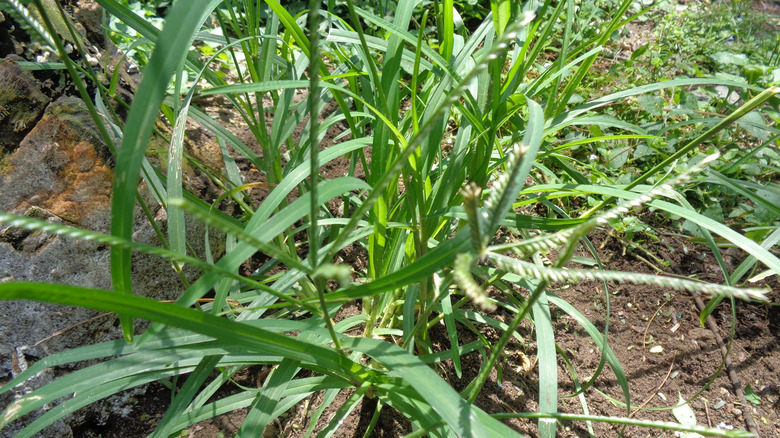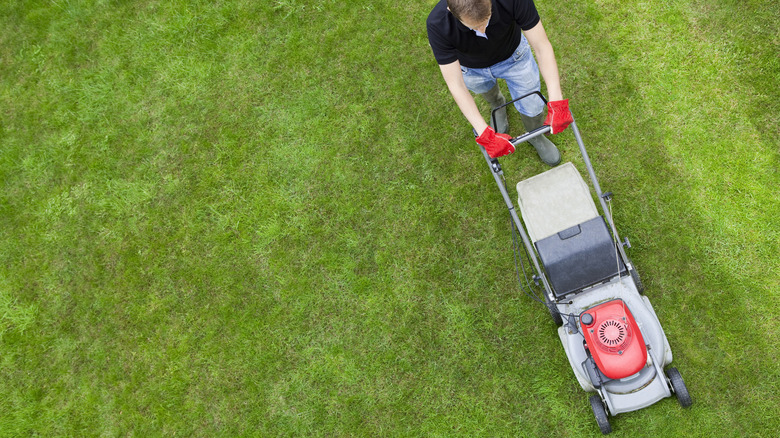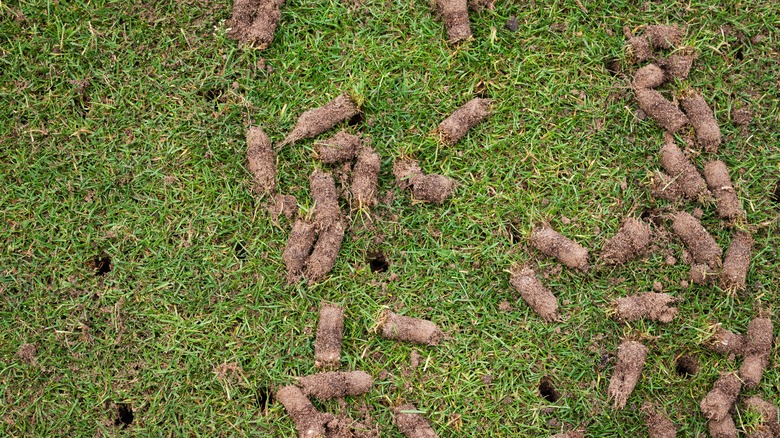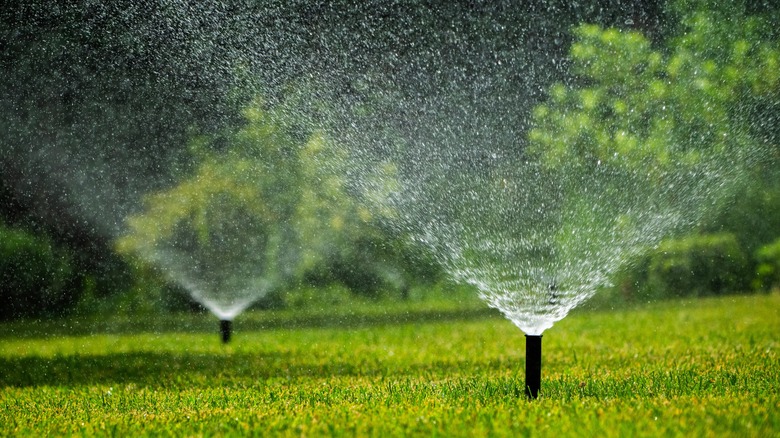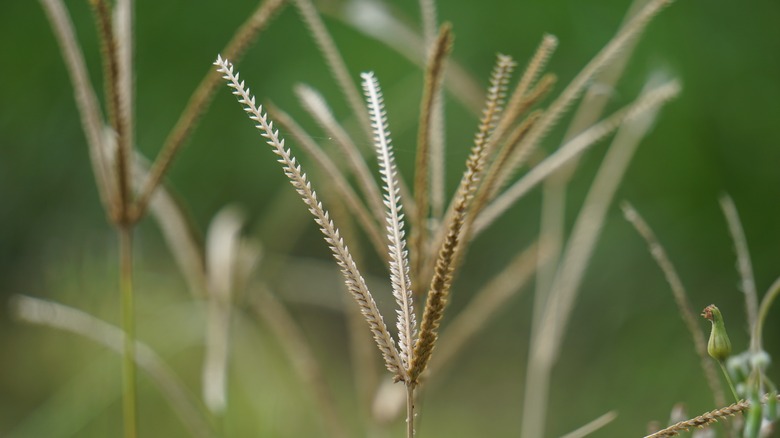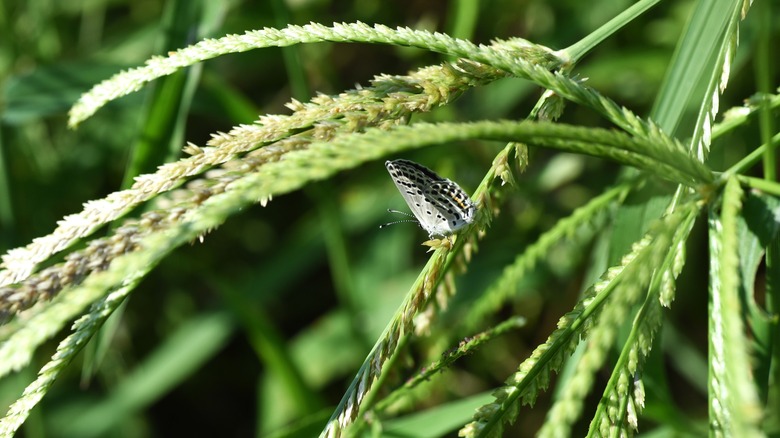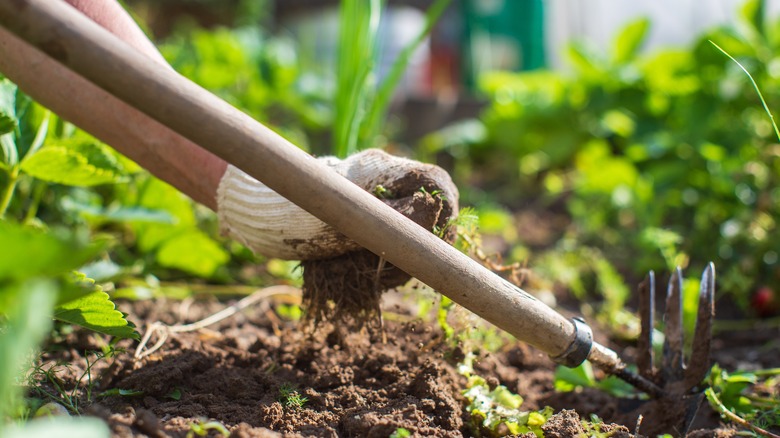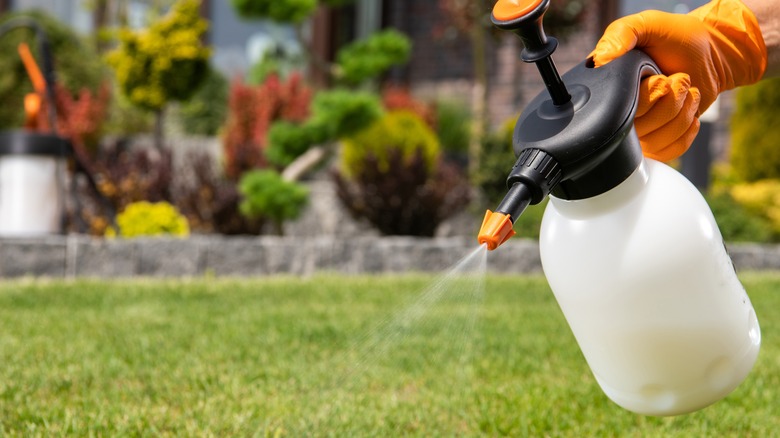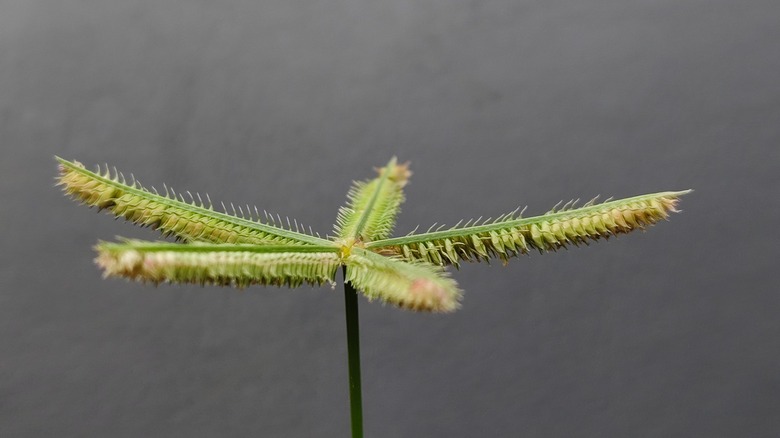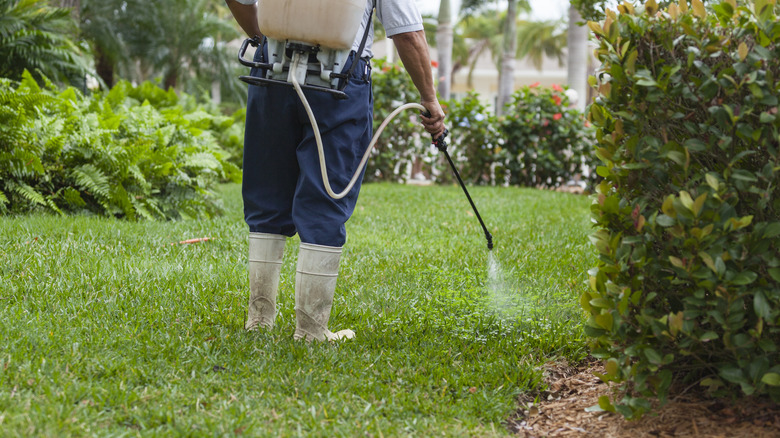Tips & Tricks To Prevent Goosegrass From Growing In Your Yard
Goosegrass (Eleusine indica) is considered one of the world's most troublesome weeds. The summer annual weed pokes its head through in inhospitable, compacted soils where desirable plants have trouble surviving, then spreads by shedding thousands of seeds before dying for the season. These "parting gifts" then germinate in great numbers come spring, and the infestation continues. Goosegrass is a common nuisance in sports fields, golf courses, agricultural fields, and residential lawns. Once it emerges, it can compete aggressively with surrounding desirable plants.
The best thing you can do to control goosegrass in your lawn is to prevent it from emerging in the first place. Keeping a healthy, thriving lawn is probably your best first line of defense. Denying the weed its preferred growing conditions, which include heavily trafficked soil, is another important strategy for preventing infestations. Since this weed spreads by seed, you must also take steps from contaminating your lawn with goosegrass seeds — which can be tougher than it sounds. And if you've failed to keep the weed off your lawn, you may try using mechanical control measures to contain the spread before it's too late. Pre- and post-emergent herbicides are the last line of defense, and are often needed if your property has suffered from outbreaks in the past. Below, we'll walk you through each of these tips for preventing and fighting off goosegrass in your yard.
Keep a dense, healthy lawn to prevent goosegrass from taking hold
Having a dense, healthy lawn is one of the best ways to keep goosegrass from becoming established. That's because strong turf grass that grows closely together effectively deprives goosegrass seedlings of the sunlight, water, and nutrients they need to become established. To keep your lawn healthy, there are several simple strategies you can follow. For one, you shouldn't mow your lawn any shorter than 3 or 4 inches. That's because goosegrass flourishes when the adjacent grass is mowed too short. Being a flat-growing species, it makes sense that it thrives when the adjacent turf doesn't block out the sun.
Your mowing frequency matters, too. If your lawn is home to cool-season grasses, such as perennial ryegrass, Kentucky fescue, or tall fescue, you should mow it more often during its growth seasons in the spring and fall, and less frequently in the summer. On the other hand, if you have a warm-season grass variety, like Bahia grass, Bermuda grass, or zoysia grass, frequent mowing should coincide with the peak of the growing season from late spring until early fall. Proper fertilization is of equal importance. Cool-season lawns should be fertilized with nitrogen fertilizer in the fall, and to a lesser extent in the spring, but not during the summer months, when the turf goes dormant. On the other hand, warm-season varieties should be fed during their period of growth in the summer months. Regardless of the grass variety you're growing, be sure to seed bald spots quickly to deny goosegrass a chance to germinate and get established in those locations.
Prevent soil compaction in your lawn
Goosegrass thrives in compacted, heavily trafficked soil. Soil that suffers from compaction is usually inhospitable to other, desirable grass varieties. Since goosegrass can tolerate it well, compacted soil becomes a competition-free growing medium where the weed can thrive without having to compete for nutrients, sun, and water. Finding that goosegrass is taking over your lawn is usually an indication that the soil is overly compacted. Aeration offers a way to reduce soil compaction and make the growing medium better-suited for sustaining your turf grass. As we discussed above, a healthy lawn typically leaves no room for goosegrass to take hold and spread.
If you're planning to aerate your lawn, be sure to time the procedure with the turf's growing season. So, if you have a cool-season lawn, the best time to aerate it is in the fall. Conversely, lawns with warm-season grass varieties should be aerated during the summer months. Use a core aerator machine to perforate your lawn's growing medium. Although spike aeration may sound more appealing due to lower costs, core aeration (in which plugs of soil are actually pulled out of the ground) is far more effective at de-compacting the soil. Core aeration also does a better job of cutting through the thatch layer and giving air, water, and nutrients access to the roots of the grass. That said, spike aeration may be suitable if you're treating a small patch that gets more traffic than the rest of the lawn, and the soil there isn't excessively compacted.
Give your lawn deep, infrequent waterings
Goosegrass seeds are most likely to germinate successfully if your lawn's topsoil layer remains moist most of the time. Light and frequent irrigation creates this undesirable condition that encourages goosegrass to emerge. You can deny the pesky weed this opportunity to germinate by giving your lawn deep, but infrequent, waterings instead. These thorough, intermittent soakings give your turf an advantage over the weeds.
How often you irrigate the lawn and how much water you give the turf depends on the type of grass you're growing. Warm-season grasses have larger root systems that are capable of reaching water deep below the ground, so you don't need to water them as often as their cool-season counterparts. One or two waterings per week will usually suffice. Aim to give the lawn about 1¼ to 1½ inches of water weekly during the growing season, then reduce the amount of watering in the fall. On the other hand, cool-season grasses should generally get watered at least three times per week, with a total of 1 inch of water given weekly. If your cool-season lawn has gone dormant in response to high temperatures and a lack of rain, keep the grass from dying with at least ½-inch of water every two weeks.
Avoid contaminating your yard with goosegrass seeds
One way to keep goosegrass from sprouting on your lawn is to prevent its seeds from ever making it to your property. Unfortunately, you can easily transfer them to your yard without knowing. For instance, if you've been playing golf or football on grass that's infested with goosegrass, or simply spent time in a neighbor's goosegrass-infested backyard, your lawn could be next. You'll never know that you picked the seeds up in an infested area, because they're tiny and indiscernible when in the soil.
A good way to avoid bringing this weed's seeds home is to stay away from places that have experienced goosegrass infestations in the past. If this sounds implausible, then take precautions and wash your shoes, gardening tools, or sports equipment after they've come in contact with potentially infected lawns (or any other lawns, if you wish to be extra safe). And if you do accidentally introduce the pesky weed at home through contamination, get rid of any goosegrass seedlings that emerge before they've had a chance to mature.
Get rid of goosegrass before it seeds
Goosegrass reproduces throughseeding. Seeding is a process in which the mature plant begins to bloom, producing male and female flowers. Eventually, the flowers give way to a seed head, which, as its name suggests, houses the grass's seeds. In the case of goosegrass, each plant's seed head can hold thousands of seeds. Once the plant sheds these seeds toward the end of its growing season, the latter will stay in the soil until spring of the following year, then germinate and infest your lawn with myriad goosegrass seedlings. If this sounds like a doomsday scenario for your lawn, that's because it is. Thankfully, you can avert this outcome by denying any goosegrass shoots in your lawn the chance to mature and reproduce.
You have plenty of time to stomp out any goosegrass seedlings before they start to seed (and little excuse for neglecting the task). Goosegrass seedlings typically sprout in late spring, or whenever the soil temperatures consistently stay above 65 degrees Fahrenheit. They start producing flowers several months later, typically in July, and keep shedding them until fall arrives. The few months between germination and seed production is your golden window of opportunity for keeping the seeds out of your soil, thus disrupting next year's growth cycle. Take advantage of this time by checking your yard frequently for signs of goosegrass and destroying any plants you come across right away.
If you can, control nascent infestations by mechanical weeding
If your lawn hasn't experienced full-blown goosegrass infestations in years past and you find only a few of the pesky plants sprouting here and there, there's no need to resort to chemical control. Instead, quickly dispatch the young goosegrass seedlings by mechanical means. You can use several different methods and tools for destroying the goosegrass plants without chemicals.
The first, and simplest, way to get rid of these weeds is to simply pull the young plants out of the soil with your hands. This method is most effective when the growing medium is wet, since water makes the soil less dense and easier to disturb. So, either wait until after substantial rainfall, or after you've irrigated the lawn. Clutching the weed close to its base, yank it straight upward until the entire root system is out of the soil. However, if you struggle to free the plant from the soil by hand, you may find that pulling weeds is easier if you use weeding tools like hoes or dandelion weeders to loosen the soil around the root. To have the peace of mind that the weed will not grow back in the same spot, make sure that no parts of the root remain in the growing medium.
If hand-pulling is too burdensome for you, try other mechanical control methods, such as occultation or solarization. Occultation involves laying down an opaque material on top of the weeds and keeping it there for at least one week — this practice denies the young weeds access to sunlight and effectively smothers them. Meanwhile, solarization entails placing a clear tarp over the weeds during the hottest months of the year, so that the resulting heat kills the young plants and their seeds.
Apply pre-emergent herbicides when the soil temperature is 62 to 65 degrees Fahrenheit
Applying pre-emergent herbicides to your lawn is the best control method if your yard has suffered from goosegrass infestations in the past. However, pre-emergent herbicides are only effective at keeping goosegrass from germinating if you apply them to the soil at the right time. The ideal time to treat your lawn with a pre-emergent herbicide targeting goosegrass is when the soil temperatures reach around 65 degrees Fahrenheit at a depth of 2 inches. Note that if you're trying to control crabgrass, too, this will likely be your second pre-emergent treatment of the spring. Since crabgrass seeds germinate at cooler temperatures than their goosegrass counterparts, you'll need to treat your lawn against crabgrass infestations earlier in the spring, then repeat the procedure later as the soil temperatures climb.
Pre-emergent herbicides known to be effective against goosegrass include prodiamine, pendimethalin, dithiopyr, and mesotrione. Make sure you follow the manufacturer's instructions closely when using the herbicides, since the optimal dosage will differ between products, and some of these chemicals may be harmful to your lawn. As a precaution, it's always best to apply pre-emergents to well-established turfs, and never before seeding your lawns. Another best practice is to irrigate the treated area within a week of applying the herbicides if no rainfall occurs. Since goosegrass develops resistance to herbicides over time, it's best to vary the chemicals you use from year-to-year.
Learn to tell goosegrass from crabgrass and quackgrass for effective weed control
Knowing that you have a goosegrass problem on your hands as soon as it develops helps you implement timely treatment procedures. Unfortunately, goosegrass closely resembles other annoying weed species, including crabgrass. However, these weeds have a different lifecycle, and must be treated with pre-emergent herbicides at different times. To make sure you're combatting goosegrass effectively, you must learn to tell goosegrass apart from crabgrass and other, similar-looking plants.
Crabgrass' most prominent characteristics are its round stem, textured blades, and a vibrant green color. Large crabgrass has hairy leaves, whereas the smooth variety is — as its name suggests — smooth. Regardless of the variety, crabgrass usually has between two and six racemes, or seed heads, growing from its stem, and the plant likes to spread along the ground. Goosegrass spreads in much the same way, but it has three distinguishing features that set it apart from crabgrass. For one, goosegrass clumps appear much flatter. Secondly, the branches are meatier than those of crabgrass, and the seed heads have a distinct, fishbone pattern. Finally, there's the color. Goosegrass is known as "silver crabgrass," and the moniker stems from the plant's pale-green leaf blades.
Use the right post-emergent herbicides if you failed to stop goosegrass from sprouting
If you weren't able to ward off a goosegrass infestation before it happened, you can try controlling the problem with post-emergent herbicides. These chemicals are designed to kill the grass after it has germinated. As you can imagine, using these herbicides can be dangerous for the health of your turf, so pick the products wisely and always follow the manufacturer's instructions during treatment.
The ideal post-emergent herbicide depends on the type of grass you're growing on your lawn. For example, if you're growing cool-season grasses like Kentucky bluegrass, perennial ryegrass, tall fescue, or fine fescue, mesotrione is a safe herbicide to use on goosegrass. On the other hand, warm-season varieties like Bermuda grass or zoysia are more tolerant of foramsulfuron. Read the dosage on the product label to ensure you're applying just the right quantity of the weed killer.
The best time to apply post-emergent herbicides is after the goosegrass has germinated. When applying the treatment, make sure that the soil is wet — the moisture helps the chemicals do their job with greater effectiveness. Another best practice for post-emergents application is to rotate the treatments every year, since goosegrass is known to become resistant to the chemicals with time.
